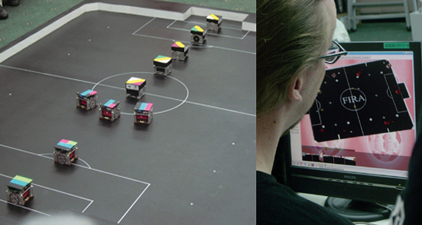
Do you remember the TV drama "KAIST," which aired six or seven years ago and portrayed the lives of KAIST students who were members of a robot soccer club? Robot soccer, which is a soccer played by human-made robots, was invented by Professor Kim Jong-hwan (KAIST) in the year 1995 and has since developed far enough around the world to lead to the creation of a Federation of International Robot-Soccer Associations. Robot soccer has spread to Ewha, too, with the club E.RO.S (Ewha Robot Soccer) established by students in the
"I always liked to disassemble and assemble electronic machines and this interest naturally led me to become interested in robots. I first encountered robot soccer when I watched the drama "KAIST" which more than raised my curiosity. I was marveled by it," said Jung Hye-jeong (Information Electronics Engineering, 4), who was the president of E.RO.S in 2006.
There are different kinds of robot soccer games which can be classified into Microsot, Robosot, Hubosot and Simurosot. Microsot is the most common of the four and it is a soccer game consisting of three robots, two players and one goal keeper, on each team. However, robot soccer cannot be played by robots alone. A computer is needed, and so is a vision system which shows the location of the ball and the robot players. Generally, a picture of the entire game is transmitted to the computer from a vision camera attached at the top of the robot soccer stadium. The computer then calculates what actions the robots should take according to the situation.
The process looks simple, but students need to develop a wireless communication system that connects the computer; robots and vision system control technology which stimulates the robots to move faster; and artificial intelligence that recognizes the location and movement of the robot players and the ball. It is not an easy process because members who want to participate in the robor soccer tournament have to research day and night to connect the computer system and robots perfectly, not to mention the inside control systems of the robot players.
Since robots and soccer are both traditionally male interests, the Ewha team has stood out among other robot soccer teams when it entered the soccer tournament, gaining a lot of attention from the media.
Students in E.RO.S plan to continue their careers researching control systems for electronic machines and eventually contribute to the development of robots. "Robots have become a part of our lives. The continuing development and interest in robot soccer is one of the many signs that robots have permeated into the human society," said Jung.

